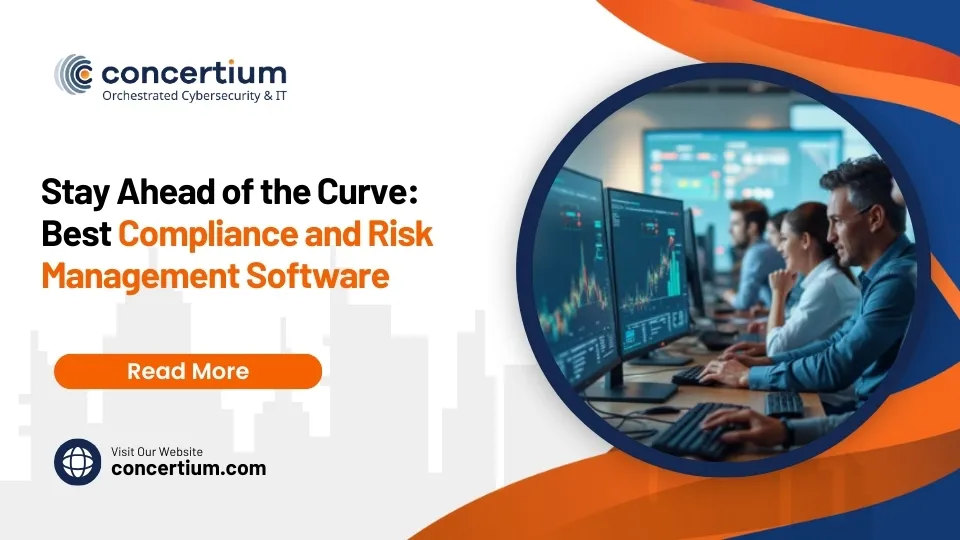Compliance and risk management software is more crucial than ever for businesses today. As cyber threats grow and regulations tighten, finding software solutions that ensure data protection and compliance becomes indispensable for maintaining trust and operational integrity. For the tech-savvy business owner, these software solutions offer three key advantages:
- Automated Compliance: Streamlines processes ensuring your business meets all necessary regulations without manual interventions.
- Real-Time Risk Assessment: Provides ongoing monitoring and alerts to tackle threats as they occur.
- Centralized Data Management: Allows seamless integration and management of all compliance-related information in one place.
When ignoring compliance and cybersecurity can lead to costly penalties and reputational damage, using the right tools is not just about ticking boxes; it’s about building a robust foundation that supports business growth while safeguarding against emerging risks.
Quick look at compliance and risk management software:
- governance risk and compliance framework
- governance risk and compliance tools
- risk and compliance tools
Understanding Compliance and Risk Management Software
Navigating compliance and risk management software can seem daunting, but it’s essential for any business aiming to stay ahead. This software is designed to simplify the complex process of meeting regulatory requirements and managing potential risks.
Risk Assessment
At the heart of any compliance tool is risk assessment. This feature helps businesses identify, analyze, and prioritize risks that could impact operations. By understanding these risks, companies can take proactive steps to mitigate them. Tools like real-time risk analysis enable businesses to react swiftly to emerging threats, ensuring that nothing slips through the cracks.
Compliance Monitoring
Compliance monitoring is another critical component. This involves continuously checking that business operations align with industry regulations and standards. Automated systems track compliance status in real-time, reducing the need for manual checks and minimizing human error. This is particularly vital in industries with stringent regulations, such as finance and healthcare, where non-compliance could lead to severe penalties.
Regulatory Updates
Keeping up with regulatory updates is a constant challenge. Laws and regulations change frequently, and businesses must adapt quickly to remain compliant. Modern compliance software provides timely updates and alerts about changes in the regulatory landscape. This ensures that businesses are always informed and can adjust their practices accordingly.
By leveraging these features, companies can not only protect themselves from potential fines and legal issues but also build a reputation as trustworthy and reliable partners in their industry.
Top Features of Compliance and Risk Management Software
Compliance and risk management software is a game-changer. Let’s explore some of the top features that make this software indispensable for modern businesses.
Automation
Automation is at the core of effective compliance and risk management. By automating routine tasks, businesses can save time and reduce errors. For instance, automated compliance checks can continuously monitor regulatory requirements, ensuring that businesses stay compliant without manual intervention.
Example: Many leading solutions in security compliance use automation to integrate risk management and run fully automated checks in real time. This not only strengthens cybersecurity but also mitigates disruptions seamlessly.
Real-Time Analysis
Real-time analysis is crucial for staying ahead of risks. This feature allows businesses to monitor their operations as they happen, providing immediate insights into potential threats. With real-time data, companies can quickly identify and address risks before they escalate.
Fact: According to a 2023 report, 62% of businesses increased their compliance budgets to improve real-time risk management capabilities.
Centralized Data
Centralized data management is another key feature. By consolidating all compliance and risk data into a single platform, businesses can improve data accessibility and integrity. This centralization simplifies data analysis and reporting, making it easier to spot trends and make informed decisions.
Benefit: Centralized data reduces the complexity of managing compliance across different departments, fostering collaboration and improving overall efficiency.
These features—automation, real-time analysis, and centralized data—are essential for any business looking to improve its compliance and risk management processes. They not only streamline operations but also provide a strategic advantage in navigating the changing regulatory landscape.
10 Best Compliance and Risk Management Software Solutions
Revolutionary Risk Assessment Methodology
In compliance and risk management, real-time risk analysis is a game-changer. This approach allows businesses to assess risks as they emerge, providing immediate insights and enabling swift action to mitigate potential issues. For example, Sprinto excels in this area by integrating risk management with automated checks, offering a seamless experience.
Expert model content is another crucial element. It provides businesses with tried-and-tested frameworks and methodologies, ensuring comprehensive risk assessments. These expert models are designed by industry leaders and offer a reliable foundation for any compliance strategy.
Streamlined Policy Management
Keeping up with regulatory updates can be overwhelming, but streamlined policy management makes it manageable. This feature ensures that businesses are always aligned with the latest regulations, reducing the risk of non-compliance. Automated systems can update policies in real time, ensuring that everyone in the organization is on the same page.
Complaint management is also vital. A robust system for handling complaints not only improves customer satisfaction but also helps identify compliance issues early. By addressing complaints efficiently, businesses can prevent minor issues from escalating into significant problems.
Integrated Vendor Management
Managing the vendor lifecycle is crucial for maintaining compliance. From onboarding to offboarding, an integrated system ensures that all vendor interactions are tracked and managed efficiently. This not only helps in compliance but also strengthens vendor relationships.
Contract management is another key component. By automating contract reviews and renewals, businesses can ensure that all agreements are compliant with current regulations. This reduces the risk of legal issues and improves operational efficiency.
Automated Audit Management
Digital workpapers and compliance templates are changing audit management. These tools automate the audit process, reducing the time and effort required to prepare for audits. With digital workpapers, businesses can easily track audit progress and ensure that all necessary documentation is in place.
Compliance templates provide a standardized approach to audits, ensuring consistency and thoroughness. These templates can be customized to fit specific business needs, making them a versatile tool for any organization.
Business Continuity Management
Effective data collection is at the heart of business continuity management. By gathering and analyzing data from various sources, businesses can identify potential disruptions and plan accordingly. This proactive approach ensures that operations continue smoothly, even in the face of unexpected challenges.
Emergency communications are essential for maintaining business continuity. A reliable communication system ensures that all stakeholders are informed and coordinated during a crisis. This minimizes downtime and ensures that the business can quickly return to normal operations.
These solutions—real-time risk analysis, expert model content, regulatory updates, complaint management, vendor lifecycle, contract management, digital workpapers, compliance templates, data collection, and emergency communications—are integral to effective compliance and risk management. By adopting these tools, businesses can improve their operational resilience and stay ahead of the curve.
Benefits of Using Compliance and Risk Management Software
Cost Savings
Investing in compliance and risk management software leads to significant cost savings. By automating manual processes, businesses can reduce the time and resources spent on compliance tasks. This automation minimizes human errors and the need for extensive staff training, cutting down on labor costs. Furthermore, software solutions help avoid hefty fines and penalties associated with non-compliance, safeguarding your financial resources.
Improved Efficiency
Efficiency is a vital benefit of adopting compliance software. With centralized data systems, businesses can streamline their operations and ensure that everyone has access to up-to-date information. This eliminates redundant processes and allows teams to focus on more strategic tasks. Real-time updates and automated workflows mean that compliance teams can react swiftly to changes, maintaining alignment with regulatory standards effortlessly.
Strategic Advantage
Using advanced compliance software provides a strategic advantage in today’s business environment. Companies that leverage these tools can turn complex compliance requirements into a competitive edge. By ensuring that all processes are compliant, businesses build trust with customers and stakeholders, enhancing their brand reputation. Additionally, robust risk management frameworks enable organizations to identify and mitigate risks promptly, securing a safer operational landscape.
In summary, compliance and risk management software not only saves costs and improves efficiency but also offers a significant strategic advantage, helping businesses thrive in a competitive market.
Frequently Asked Questions about Compliance and Risk Management Software
What is a risk management and compliance program?
A risk management and compliance program is a structured framework that organizations use to identify, assess, and manage risks while ensuring adherence to regulatory requirements. These programs often include guidelines and procedures that help companies stay compliant with laws such as the Financial Intelligence Centre Act (FIC Act). This act, for example, requires businesses to monitor and report suspicious transactions to prevent money laundering and other financial crimes.
Key components of a risk management and compliance program include:
- Risk Assessment: Identifying potential risks that could impact the organization and evaluating their likelihood and impact.
- Compliance Monitoring: Continuously checking that the organization adheres to relevant regulations and standards.
- Policy Development: Creating and updating internal policies to guide employees in compliance matters.
What is the best risk management software?
The best risk management software varies depending on the specific needs of an organization. However, top-rated solutions often share some common features:
- Real-Time Risk Analysis: Tools that provide up-to-date insights into potential risks, allowing businesses to act swiftly.
- Automation Capabilities: Software that automates routine tasks, reducing the burden on compliance teams and minimizing errors.
- Customizable Dashboards: Interfaces that allow users to tailor the software to their specific risk management needs.
When evaluating software, consider product listings and ratings from trusted sources. These can offer valuable insights into how well a product performs in real-world scenarios. Look for solutions that have a strong market share and are known for their reliability and effectiveness.
What is the best software for compliance?
The best software for compliance is one that aligns with your organization’s regulatory requirements and operational needs. Leading technologies in this space often include:
- Comprehensive Reporting Tools: These help organizations document and demonstrate compliance efforts to regulators.
- Centralized Data Management: Systems that store all compliance-related data in one place, making it easier for teams to access and analyze information.
- Regulatory Updates: Software that automatically updates to reflect changes in laws and regulations, ensuring continuous compliance.
When choosing a compliance software, look at industry reviews and product ratings to understand its performance and reliability. Consider solutions that are widely recognized for their innovation and ability to adapt to new compliance challenges.
By understanding these aspects, businesses can select the right compliance and risk management software to support their operational and regulatory needs.
Conclusion
At Concertium, we pride ourselves on delivering custom solutions that address the unique challenges faced by businesses today. Our nearly 30 years of cybersecurity expertise empower us to provide custom services that improve your organization’s security posture and ensure compliance with evolving regulations.
Our approach is simple: we focus on understanding your specific needs and crafting solutions that fit seamlessly into your existing processes. Whether it’s integrating cutting-edge technology for threat detection or developing comprehensive risk management strategies, our goal is to protect your digital assets while minimizing disruptions.
Our Collective Coverage Suite (3CS), featuring AI-improved observability and automated threat eradication, is designed to keep you ahead of the curve in a rapidly changing digital landscape. By choosing Concertium, you’re not just investing in a service; you’re gaining a partner committed to your success and peace of mind.
Ready to improve your compliance and risk management capabilities? Contact us today to learn more about how our solutions can safeguard your business and help you thrive in today’s digital world.





